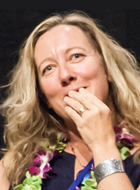| |
 |
| |
| |
 |
Ken Buesseler, Senior Scientist, Woods Hole Oceanographic Institution
|
Dr. Ken Buesseler is a marine radiochemist and Senior Scientist at the Woods Hole Oceanographic Institution (WHOI) and Director of the Center for Marine and Environmental Radioactivity at WHOI that he founded in 2013. Dr. Buesseler received his PhD from Massachusetts Institute of Technology and Woods Hole Oceanographic Institution in 1986. He is best known for work using natural and manmade isotopes in the ocean. More specifically, his work includes studies of fallout from atmospheric nuclear weapons testing, assessments of Chernobyl impacts on the Black Sea, and examination of radionuclide contaminants in the Pacific resulting from nuclear testing on the Marshall Islands as well as more recently from the Fukushima nuclear power plants. He pioneered the use of the naturally occurring radionuclide thorium-234 in studies of particle cycling and the ocean carbon cycle. This thorium based flux proxy has been widely used, including by Dr. Buesseler to quantify the transport carbon from the surface to deep ocean in response to the addition of soluble iron, an approach that may lead to methods to purposely alter ocean ecosystems and geochemistry to remove carbon dioxide from the atmosphere and store additional carbon in the deep sea as a way to reduce suffering due to climate change. As part of this work, Dr. Buesseler participated in two ocean iron fertilization (OIF) experiments, leading one of three research vessels during the last major US OIF experiment off Antarctica. He is author on more than 190 research publications with 11 papers focused on OIF. He leads a new consortium called Exploring Ocean Iron Solutions and is active in promoting studies of ocean carbon dioxide removal (CDR), including his participation as co-author on the US National Academies study released in 2021 on ocean CDR. In recognition of his achievements, in 2009 he was elected Fellow of the American Geophysical Union; in 2013 selected as foreign member of the Dutch Academy of Sciences; in 2018, elected as a Fellow of the American Association for the Advancement of Science; and in 2021, elected as a Geochemistry Fellow of the Geochemical Society and European Association of Geochemistry. In 2011 he was noted as the top cited ocean scientist by the Times Higher Education for the decade 2000-2010. Finally, he has participated in public engagement throughout his career, including via his citizen-scientists campaign “Our Radioactive Ocean”. More info at his Café Thorium web site.
|
| |
|
 |
Angela Falciatore, Research Director, Laboratory of Chloroplast Biology and Light-sensing in Microalgae UMR 7141 CNRS-Sorbonne Université & Institut de Biologie Physico-Chimique Paris
|
Dr. Angela Falciatore is Research Director of the French National Centre for Scientific Research (CNRS) and Director of the Department “Chloroplast Biology and Light sensing in Microalgae” at the Institut de Biologie Physico-Chimique in Paris. She completed her PhD degree in 2002, by performing pioneering research on the perception of environmental signals in marine diatoms at the Stazione Zoologica Anton Dohrn, Naples, Italy. She conducted post-doctoral research on the chloroplast-to-nucleus retrograde signalling in Chlamydomonas reinhardtii at the University of Geneva, Switzerland. Complementary activities at the Okazaki National Institute for Basic Biology, Japan (1997), and at the Carnegie Institution of Washington, Stanford University, USA (2003), contributed to enlarge her expertise in photobiology. In 2005, she started an independent research activity at the SZN, Italy. At the end of 2009, she established and led the team “Diatom Functional Genomics” at Université Pierre et Marie Curie in Paris. Since 2019, she is the Head of the Laboratory of “Chloroplast Biology and Light Sensing in Microalgae,” affiliated with the CNRS and Sorbonne University.
A major focus of her research has been to establish diatoms as new model systems for marine biology and photobiology by developing genomic resources and genetic tools. Combining physiological, biophysical, biochemical, and genome-wide molecular approaches, her team has characterized diversified photoreceptors, fostering novel hypotheses on the role of these sensors in controlling growth and adaptive responses in a marine context. She also uncovered the existence of a long-foreseen diatom circadian clock, which controls essential rhythmic processes in these algae. Her team also contributed to disclose some of the diatom-specific photoacclimation properties, by identifying critical regulators of photosynthesis that also influence the natural variability of diatom photoresponses.
|
| |
|
 |
Eric Galbraith, Professor, McGill University
|
Dr. Eric Galbraith is a professor of Earth System Science at McGill University in Canada. He completed his PhD in oceanography at the University of British Columbia in 2006. He has worked as a research associate at Princeton University in the United States, and as a research professor for the Catalan Advanced Research Institute based at the Autonomous University in Barcelona. His research is broadly interdisciplinary, and is generally concerned with using numerical models and data analysis to better understand global sustainability challenges at the intersection between climate change, human activities and ecosystems. He has worked on both past and anticipated climate changes and their links with ocean biogeochemistry, general principles of air-sea exchange, nutrient cycling and ecosystem stoichiometry, the long-term dynamics of fisheries, and the global quantification of human activities. Research in his Integrated Earth System Dynamics group has made pioneering contributions to coupled global fisheries-ecosystem modelling, to quantifying connections between biogeochemistry and large animals, to providing global constraints on the marine size spectrum of life, and to measuring the subjective well-being of fishers in low income coastal communities. He was a founding coordinator of the fisheries and marine ecosystem model intercomparison project (Fish-MIP).
|
| |
|
 |
Juliet Hermes, Professor, South African Environmental Observation Network & University of Cape Town
|
Dr. Juliet Hermes has significant experience with developing, coordinating and managing national, regional and international longterm, multidisciplinary, ocean observations and numerical modelling programs. She leads a team focussed on the marine offshore environment around southern Africa as part of the Government funded South African Environmental Observation Network and she is also managing the South African Polar Research Infrastructure. Dr. Juliet Hermes commits a lot of her time to standards and best practices through her role as a vice chair of the GOOS Observation Coordination Group, as well as through the IOC/GOOS Ocean Best Practices Group. Her involvement in the CLIVAR Indian Ocean Regional Panel as well as the GEO Blue Planet, the Indian Ocean Rim Association, GCOS and working with the African Group Negotiators Experts Support have allowed her to gain a greater understanding of policy and the users of ocean observing systems.
Dr. Juliet Hermes is also a Professor, at the University of Cape Town and the Nelson Mandela University, where she has supervised over 40 students and co-authored more than 50 papers. However, her passion is in fostering regional and international collaborations as well as developing capabilities across regions, cultures and varying skillsets. Dr. Juliet Hermes focuses attention on development through ensuring knowledge generation and sharing and providing an enabling environment to grow a diverse, inclusive cohort of ocean scientists.
|
| |
|
 |
Lisa Levin, Professor, Scripps Institution of Oceanography, University of California, San Diego
|
Now emeritus, Dr. Lisa Levin served from 1992-2022 as Professor of Biological Oceanography at the Scripps Institution of Oceanography, University of California, San Diego. Dr. Levin also served for 6 years as Director of the Center for Marine Biodiversity and Conservation at Scripps. Prior to working at Scripps, she was a professor for 9 years at North Carolina State University in Raleigh, NC.
Dr. Levin is passionate about the deep sea and researches the ecology of different ecosystems on deep continental margins, their vulnerability to climate change and to human resource extraction. To bring deep-sea science to ocean policy making Dr. Levin helps lead both the Deep-Ocean Stewardship Initiative and the Deep-Ocean Observing Strategy and actively contributes to IPCC reporting and the World Ocean Assessment. Over the past 40 years she has led or participated in over 50 expeditions to the Pacific, Indian and Atlantic Oceans. Dr. Levin has published over 300 peer-reviewed papers and is a Fellow of both the American Geophysical Union and the American Association for the Advancement of Science. She has given the IOC-UNESCO Anton Bruun (IOC-UNESCO), Sverdrup (AGU), and Revelle (US National Academy) Medal Lectures, and was awarded the ALSO Redfield Lifetime Achievement Award in 2018 and the Prince Albert 1 Grand Medal in Science in 2019.
|
| |
|
 |
Haojia Abby Ren, Associate Professor, Taiwan University
|
Dr. Haojia Abby Ren is an associate professor in the Department of Geosciences at Taiwan University. Dr. Ren received her PhD in Geosciences from Princeton University, U.S. Upon receiving her PhD, she was awarded NOAA Climate and Global Change Postdoctoral Fellowship, and worked at Lamont-Doherty Earth Observatory, Columbia University. She was also awarded the Distinguished Postdoctoral Fellow at Academia Sinica (Taipei), before she joined the faculty at Taiwan University. Her research interests are focused on understanding the interaction between biology and the environmental conditions through the course of Earth history. In particular, she works on emerging disciplines and techniques to study the fluxes and cycles of biologically important elements, such as nitrogen and carbon, which can be then used to identify the biogeochemical processes and feedbacks that stabilizes the Earth system. She is currently working on developing planktonic foraminifera shell-bound nitrogen isotopes as a paleoceanographic tool to reconstruct past history of the marine nitrogen cycle. This work has resulted in a new method for measuring foraminifera-bound nitrogen isotopes, that is ≥2 orders of magnitude more sensitive than previous techniques. Dr. Ren has published her work in various high-impact international journals in her field, including 4 paper on Science and 2 paper on Nature since 2009, and has received Taiwan Promising Women in Science Award, John Hedges Honorary Visiting Scholar, Nanne Weber Early Career Award in Paleoceanography, Ta-You Wu Memorial Award, Teaching award from Taiwan University, AOGS Early Career Researcher Distinguished Lecture, Charlotte Elizabeth Procter Honorific Fellowship, and Schlanger Ocean Drilling Fellowship. |
| |
|
| |
|
|
|
|
|
|
|
|